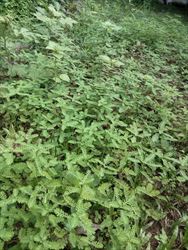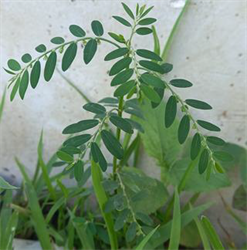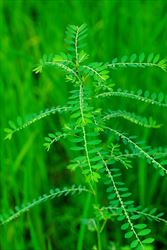Seed-under-the-leaf; it is also known as gale of the wind, stonebreaker.
Pacific Pests, Pathogens, Weeds & Pesticides - Online edition
Pacific Pests, Pathogens, Weeds & Pesticides
Seed-under-the-leaf (509)
Phyllanthus niruri. It is a member of the Phyllanthaceae. Previously, it was placed in the Euphorbiaceae.
Asia, North (Florida), South and Central (Nicaragua) America, the Caribbean (Puerto Rico), Oceania. It is recorded from New Zealand and Fiji.
Common weed of both cultivated and waste land. It tolerates waterlogged areas, and is a weed of rice paddies, growing on the sides of ditches. It's long tap root also enables it to grow in very dry areas. CABI reports that it is considered a pioneer species, the first to colonise disturbed ground, and emerging at the start of the rainy season (Photo 1).
Annual plant, up to 60 cm tall (but usually shorter), with round, smooth, green stems, erect or spreading, woody at the base. Leaves, compound, up to 18 cm long, with oval leaflets (4.5-9 mm long, 3-4.5 mm wide), alternating along the stem, and without stalks or with very short stalks (Photo 2). Flowers, small, greenish, short stalked, in pairs beneath the leaves, in the axils of the leaflets (Photos 3&4). They are either male or female. Fruits are smooth, green, with three cells; seeds are minute, wedge-shaped, brownish. Plants have thin, wiry taproots.
Spread is by seed during mowing, slashing and as a contaminant on machines and vehicles. It is also possible to be spread in turf grass because of it short stature.
Once established, Phyllanthus niruri is difficult to control. Seed, production is high, the time between seed to flower is short, less than 2 weeks, and there is tolerance to dintroaniline herbicides (e.g. pendimethaline). Also, it is tolerant of drought.
Reports of impacts are not well recorded. As for indirect impacts, CABI mentions it as a host of several important scale insects and mealybugs: e.g., pink hibiscus mealybugs, cotton mealybug (Phenococcus solenopsis), tobacco and silverleaf whiteflies (Bemisia tabaci), breadfruit mealybug (Icerya aegyptiaca), spherical mealybug (Nipaecoccus viridis).
There is a long history of use in Ayurvedic (Indian alternative medicine) healing practices, possibly for more than 2000 years. The plant is a component of herbal remedies, particularly for disorders of the digestive system, liver and kidneys. Also, a folk medicine of people of the Amazon. The entire plant is used to make chanca piedra, available in different forms (teas, liquids, capsules, tablets). It is perhaps best known as a cure of kidney stones. However, there are warnings on some Internet sites that a lack of research into the plant and its extracts means that safety and effectiveness cannot be assured.
BIOSECURITY
Phyllanthus niruri does not have a wide distribution worldwide, so the risk of introduction of this weed may not be high. However, seed is small and produced in large numbers so care should be taken that it is not a contaminant of commercial seed. Additionally, the use of this plant in folk medicines and the ease with which seed could be sent across international borders is a concern, and needs to be regulated.
BIOLOGICAL CONTROL
No information available.
CULTURAL CONTROL
- Physical & Mechanical:
- Hand weeding (and hoeing) is effective on small areas where follow-up is possible to control seedlings.
- Slashing will slow growth, but not prevent it; note, stems pieces will root and form new plants.
- Mulch:
- Maintain a layer of mulch. The seeds are small and seedlings will have difficulty penetrating a 5-10 cm layer of mulch.
- Hygiene:
- Treat vehicles and farm machinery. If moving from areas where the weed occurs to those weed-free, wash to remove soil and seed. This is equally important if the machinery is being imported into a country or moved within a country.
CHEMICAL CONTROL
In Australia, several herbicides are registered for the control of Phyllanthus species growing in a range of broadacre crops and sugarcane plantations (https://apvma.gov.au/), including: diquat/paraquat; flumioxazin; hexazinone/diuron; amicarbazone; isoxaflutole/terbuthylazone. In Fiji, glyphosate.
--------------------
Note, EU approval to use glyphosate ends in December 2022; its use after that date is under discussion. Diquat and paraquat are no longer approved for use in the EU, and paraquat is no longer approved for us in Fiji.
____________________
When using a pesticide, always wear protective clothing and follow the instructions on the product label, such as dosage, timing of application, and pre-harvest interval. Recommendations will vary with the crop and system of cultivation. Expert advice on the most appropriate herbicides to use should always be sought from local agricultural authorities.
AUTHORS Grahame Jackson & Makereta Ranadi
Information from weeds of Fiji. Department of Agriculture Bulletin No.35: 73-74; and CABI Phyllanthus niruri (seed-under-the-leaf) (2019) Crop Protection Compendium. (https://www.cabi.org/cpc/datasheet/46049); and from Czarnota M (2006) CAES Newswire. College of Agricultural & Environmental Science. University of Georgia. (https://newswire.caes.uga.edu/story/2633/leaf-flower-woes.html). Photo 1 Dvellakat. Kizhanelli is a medical liver tonic. Wikimedia Commons. (https://commons.wikimedia.org/wiki/File:Kizhanelli_3.jpg). Photo 2 Challiyan. Phyllanthus niruri,jpg. Wikipedia Commons. (https://commons.wikimedia.org/wiki/File:Phyllanthus_niruri_.jpg). Photo 4 Vengolis. Phyllanthus niruri. Wikimedia Commons. (https://commons.wikimedia.org/wiki/File:Phyllanthus_niruri_03520.jpg).
Produced with support from the Australian Centre for International Agricultural Research under project HORT/2016/185: Responding to emerging pest and disease threats to horticulture in the Pacific islands, implemented by the University of Queensland, in association with the Pacific Community and Koronivia Research Station, Ministry of Agriculture, Fiji.







